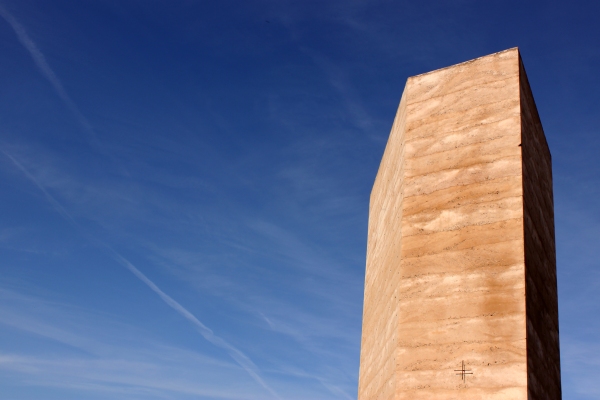Common Ground
Reactions to Church San Benedetg
See all images of Church San Benedetg here
Passing by split cliff faces of granite and limestone and swift rivers slicing through a valley, the clouds rolled west with the train. The sunlight crept softly through the clouded sky with the rain shimmering as it fell. A beam of light peered through the cracks of the clouds, falling upon the empty seat across from me, then departed as quickly as it came.
The village seemed to grow upon the mountainside, stopping just before the dense forest halfway up. Dirt roads wound dramatically up the face of the hill, wove up through the town and far beyond what could be seen from the small train station. I had beaten the rain to Sumvitg, so I began the trek to Church San Benedetg as the first few drops began to speck the dust in the path ahead of me.
LFPZ Exhibit: Jan. 24th-Feb. 7th at USC
The USC School of Architecture and the USC Architectural Guild will be kicking off the Traveling Fellows Exhibit 2011 with an opening night reception on Monday, January 24th at 6:30 PM. You’ll find the exhibit in the Verle Annis Gallery in Harris Hall on the USC Campus (map). This event is free and open to the public, so please come by and have a look. I will be unveiling the LFPZ musical score at the reception.
The exhibition will include the LFPZ project, as well as the work from 14 other Fellows who have conducted research across the globe, including China, Morocco, and The Netherlands. You can find more information about the exhibit below or at the event page on the USC Architecture website.
Kolumba
After a long hiatus, Atmosphere + Memory is back. Since my last post, I’ve been analyzing everything I learned on my trip and reevaluated my goals for this project. I’ve written some of the score, with a lot left to go. However, from now on, I’ll be rejuvenating this blog. New posts will be coming, to finish out my reactions to each project. And, once the score is complete and my exhibition design begins, I’ll be sharing that, too.
As always, thank you for following the project.
Without further ado, here are photos from Kolumba Art Museum in Cologne, Germany.
Bruder Klaus Kapelle
Kunsthaus Bregenz
What Makes Us Human
Reactions to the Shelters for Roman Archaeological Site
See all images of the Shelters for Roman Archaeological Site here
There are many ways that architecture can stimulate us. We can be enthralled by theoretical concepts that intend to revolutionize how we interact with our buildings. We can be overcome by the metaphors underlying a project’s design. And, at times, we are able to separate ourselves from these more cerebral desires and draw intrigue based solely on our reactions to space and form.
Personally, I’m interested in this last type. Reactions are what tie us back to our purely human instincts, to the universal senses which connect us all. Responding to space and material in an almost reptilian way, we absorb our surroundings from the beginning of our existence, internalizing our sensibility. Our past experiences shape our perception and, in turn, each new experience reshapes the next. Hence, it is that which makes us most human that ties us so intimately to architecture. Perhaps that’s what I’m most interested in – what makes us human.
Therme Vals
Church San Benedetg
The Vibration and the Noise
Since I arrived in Switzerland, I’ve been reading and re-reading two books – Thinking Architecture and Atmospheres. Each one is a collection of lectures by Peter Zumthor, in which he describes his personal thoughts on architecture. My own thoughts have arisen from the things he speaks of.
To begin, we must all agree on one single, and simple, idea: that architecture is the stage of life. Dwelling is what humans do, and it might seem redundant to say that humans must dwell in dwellings. Yet, the implication here is that the dwelling is tied to the verb; that that is its purpose, and that is its goal. When a building becomes the place where our lives may play out as they will, we’ve experienced architecture in a fundamental human fashion. Like the set to an opera, the background can and should only exist as the context for events.
